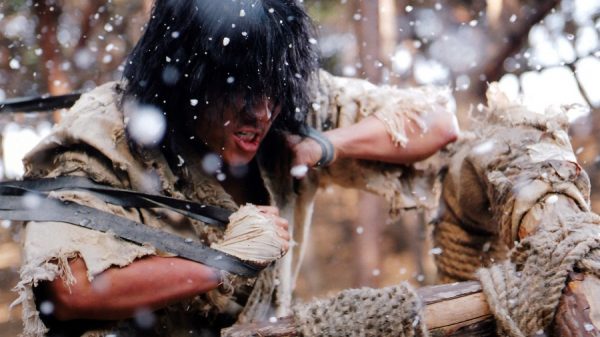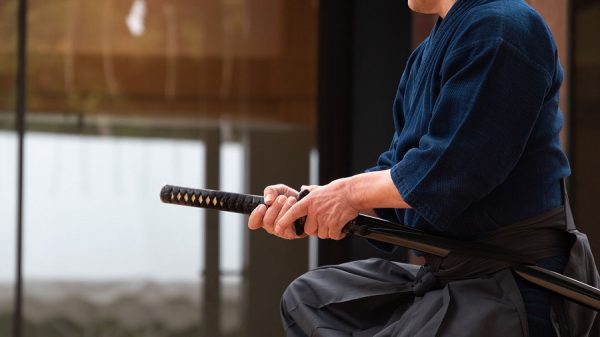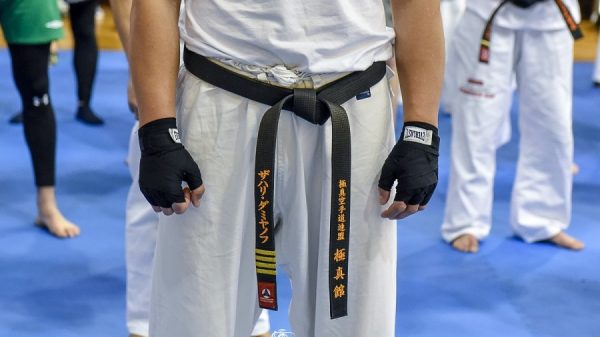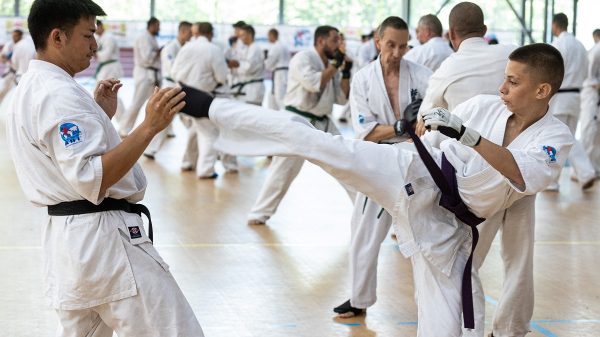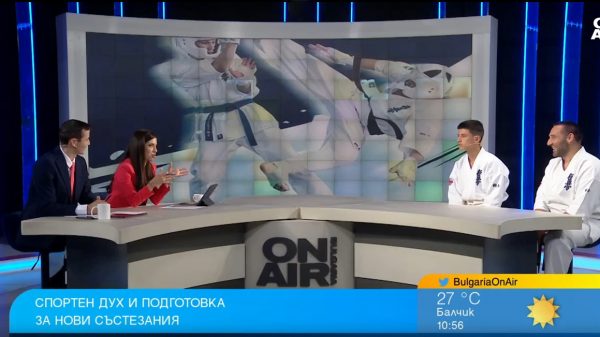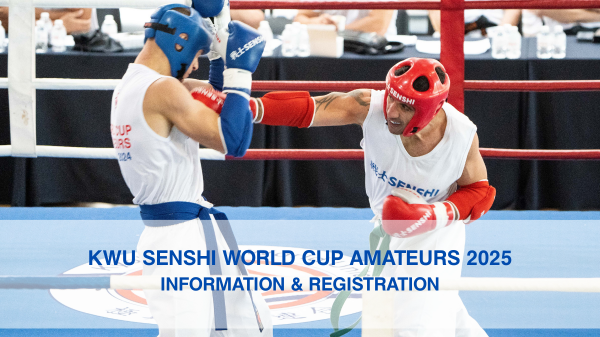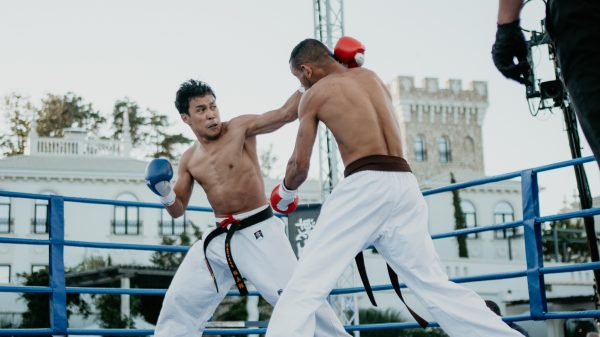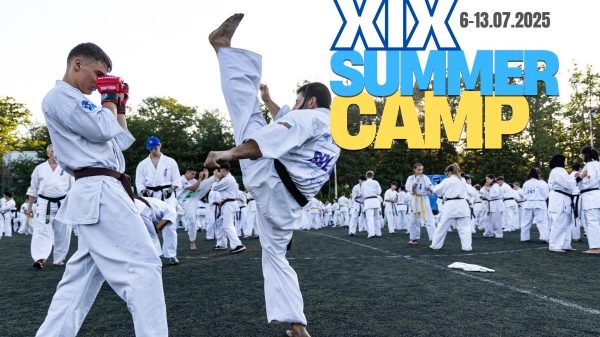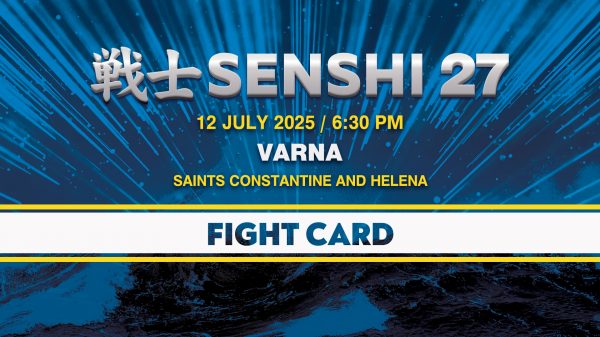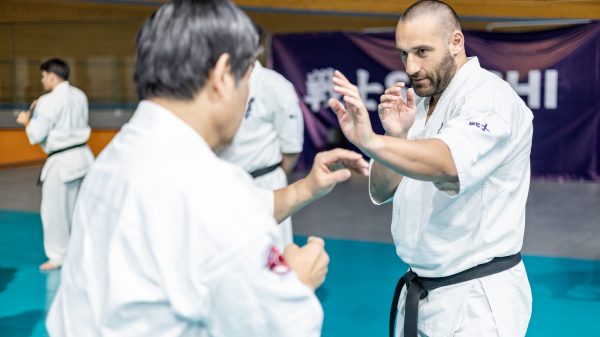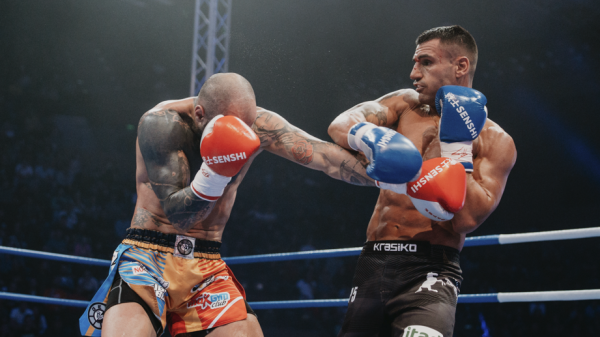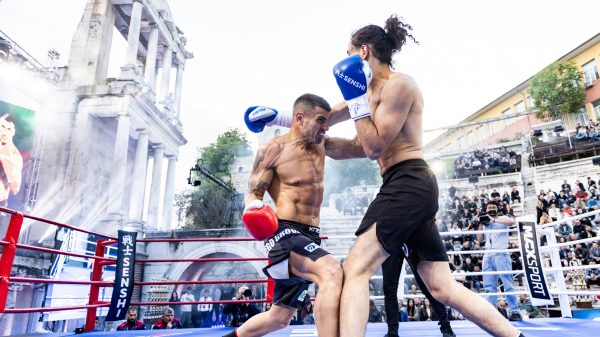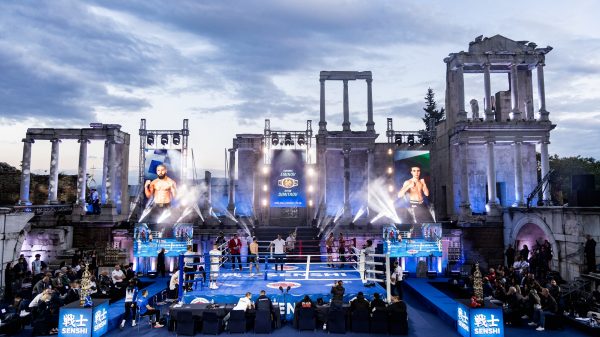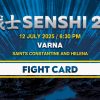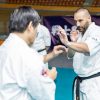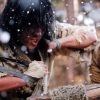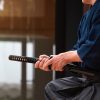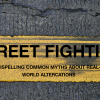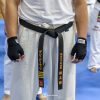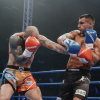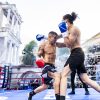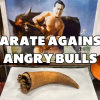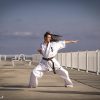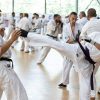Mas Oyama in America – part 2 of 3 – part 1 here
By Graham Noble: This article, or historical essay, is part of the book I am trying to write on the history of karate and its masters. This is one section of the chapter on Mas Oyama, his Kyokushinkai style, and his influence on karate history. It’s about his 1952 tour of the USA and it relies heavily on translations from Japanese material: I have to thank Mitchell Ninomiya for his translation of the old “Ooru Yamimono” article, and especially Brian Sekiya, who translated all of the other Japanese material. There wouldn’t really have been a finished piece without Brian’s input. Thanks also to Joe Lopez for his reminiscence of Mas Oyama in New York, to the OldTime Strongman site for the rare old newspaper reference Sebastian Miller , “The Rock Breaker”, and to Charles Goodin for putting this long article on his site, in full.

3. More on the Challenges
Oyama also talked about the Des Monies fight in an interview with the Japanese “Ooru Yamimono” in July 1953. This seems to be the earliest account he gave of the incident.
“When we went to Iowa”, Oyama explained, “Togo said that in order to get the attention of people we had to create a spectacle. Bricks were brought out and it was announced that $1,000 would be paid to anyone who could break one of these bricks. Then this big guy who looked over thirty came up to the stage. He said he was a state policeman and a third degree black belt in judo. Togo and I were really scared because if this man succeeded not only would the $1,000 be lost but the audience would lose interest in me and Togo would lose his base in Iowa. If you have power you can break one brick but if your striking hand is oily you can’t. You should wash your hands with soap and put a white towel on the brick then it is easier to break. But this guy didn’t know that and his hands were sweaty so he couldn’t break it. Despite the fact that his hand was bleeding he could not break the brick even after several tries. After I broke it on the first try, the officer, not wanting to lose face in front of the crowd, challenged me to a wrestling match and I accepted. The audience was in a frenzy and the guy was deadly serious and looked as if he wanted to kill me. I felt like I’d kill him or he’d kill me. It became an extremely intense match. Now I figured that if I went at him directly without thinking I would lose because I was physically smaller. However, I was really good at poking eyes because I had been practicing it a thousand times a day. When you poke the eyes you really get close to the opponent and put your hand below his nose but you don’t have to put power in the hand. So I did it and he was surprised. Then in the next moment I kicked him in the testicles. He fell down. It took a minute and a half. But in the States it is a foul to kick the opponent there, so the audience got angry. I thought it was ok — After all it was karate. Everyone was yelling ‘We’ll kill you!’ and empty coke bottles showered the stage like rain. Finally I could leave but only by police escort. This was a really bad experience”.
Much later, in another retelling of the tale, “My Karate Journey Round the World” (“Kyokushin Karate” magazine, Vol. 9 No. 1) Oyama actually gave a date for this fight: “The day after I escaped from the Iowa City (April 9, 1952) an article in a local paper said the man I had fought had seven broken ribs and was in a critical condition. Some time later I heard a rumour that he was dead. I have always since hoped that this was not true”.
So the Des Moines policeman keeps appearing in all these accounts, and in fact this match is the only one where there is a reference in the 1952 clippings. A short, unidentified article from one paper refers to “Mild spoken and quiet Masutatsu Oyama of Tokyo . . . who goes under the professional name ‘Mas Togo’ and is also known as ‘Thunderbolt Togo'” and it mentions that he is due to appear on an upcoming TV show hosted by Art Baker called “You Asked For It”. The article also states that “Oyama said that once in Iowa he offered $1,000 to anyone who could beat him in wrestling. A hefty policeman got into the ring and the duel resulted in seven broken ribs for the man in the blue suit. ‘I didn’t mean to get rough but he appeared too serious for my own good’, Oyama humoured”.
At the top of that clipping is a photograph of Oyama breaking a stone and the photo is credited to “Rafu Shimpo”, the Los Angeles based Japanese language newspaper, and “Rafu Shimpo” too had a short article on Mas Oyama in its edition of 18 July 1952. It reads:
“Ever since the victory at the All Japan Championship in the twenty second year of Showa (1947) at Kyoto, 6th dan karateka Masutatsu Oyama has been known to have an undefeated record since the end of the war. Oyama is currently staying with Great Togo on the West Coast after completing a tour of the East Coast, Canada and Cuba. He is scheduled to appear on the TV show ‘You Asked For It’ to demonstrate his karate skills.
“Oyama is a graduate of Takushoku University and a junior of Masahiko Kimura, 7th dan judoka, who came to the United States prior to Oyama’s arrival. Oyama, known here in the States as ‘Mas Togo’ stands 5 feet 8 inches tall and spent approximately thirteen years studying under Gichin Funakoshi.
“During his tour of the East Coast Oyama engaged in $1,000 winner take all challenge matches, defeating all comers within three minutes. When Oyama accepted a challenge from a policeman in Iowa who stood over 6 feet and weighed 250 pounds and was 3rd dan in judo, he reacted to the challenger’s rough tactics and retaliated with a series of chudan zuki, breaking seven of the challenger’s ribs and sending him to the hospital. The fight lasted a mere minute.
“In his up coming TV appearance Oyama is scheduled to demonstrate kata, basic exercises, breaking stones and roofing tiles, and bending a 50 cent coin with two fingers.. Since this will be his first public demonstration of this kind, there is excitement around his appearance.
“Oyama is planning to leave for Hawaii on the 22nd to join Masahiko Kimura, and tour for approximately ten days prior to returning to Japan. Oyama is planning on coming to the States next April for his second tour of the USA”.
For the record, Nei-Chu So, Mas. Oyama’s sensei in Goju ryu, recalled that before Oyama had gone to the USA he had taught him a special eye jabbing technique to use in case he became caught up in a serious fight. On his return to Japan Oyama had told So that he had had to use that technique on a big American who had challenged him. Despite all the various accounts of the Iowa policeman though, it’s curious that the June 1952 edition of “Scene”, which actually mentions the $1,000 challenge offer, refers to an incident in which “At a recent exhibition in Michigan, a powerfully built policeman in the crowd refused to believe what he saw Togo to do to a slab of brick. The sceptical cop accepted a challenge to turn the trick himself. The brick was covered with his blood, but undented when he gave up.” . . . But it doesn’t mention anything about a subsequent fight, and it says Michigan, not Iowa.
The idea of the open challenge had its precedents, going all the way back to the turn of the century when Japanese jujutsu men took on all comers in the music halls. And then in the 1950s, when Judo was really being introduced to the West, Japanese judoka would often have friendly contests with a line up of opponents. To take a random example, “Strength and Health”, October 1955, reported on Japan student champion Watanabe, who threw twenty different opponents in 21 minutes. Watanabe weighed 145 pounds while his opponents went up to 240 pounds. There were many examples like this, but then there was also Masahiko Kimura, the All Japan judo champion, who when he turned professional, seemed to have an open challenge, not just to other judoka, but to anyone. His only condition seemed to be that his opponent wore a judogi.
“Revue Judo Kodokan”, January 1953, had a brief report of Kimura’s 1951 visit to Hawaii: “The gallant challenge that M. Kimura has thrown out to the world has already brought him some surprises . . . in Hawaii, his first exhibition. Kimura (6th dan) is one of the best Japanese champions, who, over the past ten years was Champion of Japan, or one of the finalists. He broke away from the Kodokan (amicably, I believe), and he is offering 1,000 dollars to anyone who is better than him in a judogi. In Hawaii, Kimura’s first opponent came close to him and smashed him in the nose with a magnificent punch, and then immediately jumped out of the ring to hide! The “spiritual pursuit” which then took place amongst the audience lasted eight minutes. When at last Kimura caught his adversary he threw him into the chairs and an atemi knocked him dizzy. Kimura’s second opponent lasted 15 seconds before a shoulder throw left him unable to continue. The United States which is his next stop is preparing to welcome him”.
So maybe the idea of the $1,000 challenge came from Kimura. On the other hand, in the 1953 “Ooru Yamimono” interview it is the Great Togo who thinks up the offer of $1,000 to anyone who can break a brick, whereas in the 1955 series of articles Oyama says the idea of a $1,000 challenge originally came from Dick Real. And this is just one of several inconsistencies in the various different accounts. In the early 1952 newspaper references, the Iowa policeman is hit by a series of chudan zukis which break seven of his ribs, and that is repeated in the Japanese “Toto Shinbun” articles and in Jay Gluck’s account.. Yet in his 1953 interview Oyama himself said that he had jabbed the policeman in the eyes and kicked him in the testicles, meaning incidentally that by western fighting standards he had committed two serious fouls on the man. In the “Toto Shinbun” and Jay Gluck articles it is Dick Real who suffers an eye jab, or an eye jab feint, before being hit by three punches to the body. Jay Gluck refers to Becker as a boxer and states that he was beaten by a spearhand thrust, while Oyama states that Becker was a wrestler and was knocked out by a punch. Gluck says that during that fight Oyama went out of the ring from a slip as he tried to reach Becker while Oyama himself wrote that he was knocked out of the ring by a Becker blow to the jaw. Only Jay Gluck mentions the fight with Dan Calendar.
There was a pro wrestler called George Becker. He died in 1999 at the age of eighty five, and he had wrestled professionally from the 1930s all the way through the 1960s. In fact he and Johnny Weaver won the NWA Atlantic Coast Tag Team title in September 1971, when he would have been approaching sixty. George Becker was heavily involved in tag team wrestling from the early 1950s but before that he had wrestled alone, primarily as a light heavyweight. In a 1938 clipping he is referred to as the Champion of the Atlantic Seaboard, and in 1939 he dropped down to middleweight for a bout for the Pacific Coast Middleweight Championship. In that same year in New York he defeated Dave Levin for the World Light Heavyweight title. After the war he held the California State Heavyweight title for a while and then in the early 1950s he settled in Charlotte, North Carolina as a booker for Jim Crockett senior’s Mid Atlantic promotion. From that time he seemed to concentrate on tag team wresting with a number of different partners. He was a well known and popular figure in the North Carolina pro wrestling scene.
Charlotte, North Carolina, is of course, the place where Mas Oyama said he had his desperate fight with George Becker, and in the early editions of “What is Karate?” there is a photo titled “At Charlotte, North Carolina, with Mr. George Baker”. This is almost certainly George Becker, although he doesn’t look much like Mas Oyama’s description of him, which is that “Becker . . . had a very thick chest, with bear-like hair”. He has his arm round Mas Oyama’s shoulder, and both men are smiling at the camera. Becker, who would have been thirty eight years old at the time, looks ready to go in the ring, but Oyama is dressed in his ordinary street clothes. It’s one of the numerous snapshots taken by Kokichi Endo on the tour, and it doesn’t look anything like a photo of two men who are about to have, or have had, “a death match”. And if you search the internet for George Becker you get a fair number of results, some of which give his title history, but if you search for George Becker and “Togos”, “Great Togo”, “Ko Togo”, “Mas Togo” or “Mas Oyama” you get nothing. Since George Becker turned to tag team wrestling around this time it’s possible he may have had a tag match against the team of The Great Togo and Ko Togo (Kokichi Endo), although no report of such a match is known. There doesn’t appear to be any record at all of a match with Mas Oyama, or “Mas Togo”.
There seems something odd too about Oyama’s account of his fight with “Becker”. He talks about being knocked out of the ring by a punch, and then while Becker suffers a momentary loss of concentration climbing back into the ring and hitting him in the back. The two men then engage in a prolonged struggle as Becker tries to force Oyama down and the crowd go wild. Then they both go out of the ring. They continue fighting outside the ring and then as Oyama finally knocks Becker down he is hit on the back by a woman in the crowd weilding a folding chair. He knocks the woman down by a reflex action and the crowd go crazy when they see that he’s attacked a woman. . . . This doesn’t sound like a real match, no holds barred or otherwise, rather it has all the elements of a worked pro wrestling bout. Oyama would have seen many such matches in his tour of the U.S. pro-wrestling circuit and it’s quite possible that he used all of those elements in the story he wrote later for “Toto Shinbun”. Of course, he may have actually had a worked match with Becker – except that Kokichi Endo, who was there, couldn’t remember Oyama having any matches at all during that American tour.
The identity of the Iowa policeman remains completey unknown. As for Dick Real, he was described as a 6 feet 7 inch, 250 pound pro-wrestling champion, so not the kind of person who would go unnoticed. Originally, when I began to look through all this I assumed I’d be able to find him in the 1950s magazines such as, “Ring”, “Boxing and Wrestling “ and so on – but he wasn’t there. Nor does he seem to appear in the many volumes of J. Michael Kenyon’s “WAWLI (Wrestling As We Liked It) Papers”, or Scott Teal’s “Whatever Happened To?”, a magazine which looks back to the pro-wrestling eras of the 1930s to 1960s. Hisao Maki, a Kyokushinkai insider who apparently had been the ghost writer for Oyama’s “Kenka karate Sekaini Katsu” (“Combat Karate Beats Fighters of the World”), claimed in his own book, “Days with Mas Oyama”, that the story of Oyama’s challenge match with Real was a fiction. Brian Sekiya, who took an interest in the history of Oyama and the Kyokushinkai also searched through professional wrestling sources for Dick Real, without success. In some of the Japanese Mas Oyama books there is a studio photo of a wrestler who is said to be Dick Real, but when Brian checked this photo with Lou Thesz, one of the most famous champions in pro-wrestling history, Thesz said it was actually a photo of Lou “Shoulders” Newman. It seemed that Lou Thesz, who had been in pro-wrestling all his life from the 1930s, had never heard of Dick Real.
[bctt tweet=”The Japanese samurai Mas Oyama” username=”kwunion”]
There was one actual, quite well known wrestler who appears in the Mas Oyama stories, and that is Tom Rice. It was said that Oyama had beaten Rice towards the end of his 1952 American tour, in San Francisco, Tom Rice had beaten Rikidozan, the famous Japanese pro-wrestler a few months previously when Rikidozan had wrestled in the USA. Rice fought >Rikidozan later twice, in Japan, in 1956, drawing the first match and losing to Riki in the second. He is supposed to have said at the time that he had been beaten a few years before by “the Japanese samurai Mas Oyama” , but there is real doubt about that reference, and the latest thinking on Japanese websites seems to be that it is a fiction, or a fabrication, to enhance Oyama’s reputation. And it’s odd that, although the fight with Rice was said to have been Mas Oyama’s greatest victory, it isn’t included in any of the 1950s accounts by Oyama or others. It only seems to have appeared in the 1970s and again, no one has come up with a contemporary report of such a match. Brian Sekiya also contacted Lou Thesz about Oyama vs. Rice and Thesz’s reply was “I never heard of it, but Tom Rice was a football player and incredible athlete. However, he was not a wrestler or judo or karate person. Where was this guy (Oyama) when we were doing public workouts in Japan and the U.S.?” Apparently the name Mas Oyama meant nothing at all to Lou Thesz.
4. Endo
Kokichi Endo, Mas Oyama’s partner in that tour all those years ago was interviewed for a book “What is Mas Oyama?” (“Oyama Masutatsu Towa Nanika?”), published in 1995, a year or so after Oyama’s death. He was quite diplomatic, and when asked about the Oyama – Rice match; he said he hadn’t seen it, and knew nothing about it, but he had broken up with Togo sometime before Oyama so it could have happened some time after the break up. And that, he told the interviewer, was his usual answer when asked that question. But . . . .“Where was Tom Rice at that time?” he asked. He was in Hawaii, as Hawaiian champion, but Mas Oyama never had any matches in Hawaii as far as he knew. And how could you talk about a Tom Rice match without mentioning Al Karasick, who was the top promoter in Hawaii and had all the rights to Rice at that time? And, he went on “Who let the champion fight?” You had to understand, he explained, that a champion was a prized possession of the promoter: this was the world of professional wrestling and champions didn’t just engage in random challenge matches where outcomes couldn’t be controlled.
When the interviewer then said that “From your tone of voice it sounds to me that you are saying that you never saw Masutatsu Oyama fight anyone in America, not even once”, Endo threw up his hands and responded “Against who?” To the question “Is it possible that even though you never saw Mas Oyama fight wrestlers, you saw Oyama fight a boxer?” Endo’s reply was “I never saw it”
Endo did remember numerous examples of the crowd getting worked up, but then you had to remember that “The Great Togo” was “the ultimate portrayal of a heel. . . . a real dirty wrestler”, and both he and Oyama were part of Togo’s team. “So it was true that there were times we both staggered back to the hotel, escaping from the fans. But it was not like everything was on Oyama-kun’s shoulders. . . . We encountered many such incidents. For example, our car was surrounded by frantic fans yelling ‘Kill them!’. We decided not to park our car near the arena where our matches took place, because we had no idea what they were going to do with us. So we followed a rule not to stay in a hotel in the same area as the arena”But when the interviewer asked Endo about the story of him and Oyama refusing to do a fixed match, then being kidnapped by gangsters with guns and getting into a streetfight with them – and Oyama knocking out all the gangsters with his karate technique . . . Endo just smiled and said that such stories “made absolutely no sense at all”. They were just stories written to make money, just business. And the stories about Oyama’s 200 wins? — “Imagine how many years it would take to get 200 wins!” he responded.
[bctt tweet=”The stories about Oyama’s 200 wins” username=”kwunion”]
Endo, in fact, spoke well of Mas Oyama, who he had only known for those few months all those years ago. Throughout the interview he referred to him as “Oyama-kun”, which signified a degree of friendship. Endo thought he might have seen him before that American tour when he did a karate demonstration — pretty much the same demonstration he would give in the States, in fact — at a wrestling show in Yokohama featuring Endo against Masahiko Kimura. Otherwise he didn’t know anything about Oyama before they met, but he did remember that “At that time there were so many lawless areas in Japan. There were stories about a man who was willing to street fight and to do anything, a real tough man. At that time he was in the Ginza district with a certain person . . . . Even though I had just met him Oyama-kun introduced me to this high ranking person in Ginza. He was taking care of Oyama-kun. That person became a very big name later on. Oyama-kun was the kind of person who was clear on distinctions between things. I thought he could trust him”.
The certain person was the Oyabun (boss) of the Ginza. Endo recalled that “There was talk about (Oyama being a Korean) when I went to meet the Oyabun in Ginza. The meeting made me realise that there were things I didn’t understand. I was 25 or 26, still a kid really. I wasn’t mature enough to see things like I do now. Back in the old says the Oyabun never let us spend our own money. So I thanked Oyama-kun for that consideration. He said ‘Don’t worry about it. It was nothing’. I didn’t know quite what to do or how to deal with the kind of life that I witnessed. . . I thought I just met someone from an unknown world. If I describe it as they used to talk in the old days, it was a kind of society or a world where people protect each other with their lives in a real sense. I got to know how they thought at that time”. When the interviewer asked, “Did you feel the yakuza atmosphere?”, Endo replied that he didn’t want to create a misunderstanding, and that Mas Oyama “wasn’t like a cheap gang member or anything like that. He had the moral code, or code of duty of that world. He was a person of jingi, or someone with a moral code in him. I know nothing about his fights or street fights but he was a man of bigger scale than the ordinary gang members, chinpira or gorotsuki”.
Endo felt that Mas Oyama was “a man of conviction”. He would put up with routine or uninteresting things that they might have to do and he never whined or complained. “Even if he felt disinterest underneath he never showed it. His attitude was ‘Let’s do it!’ . . . He was very decisive and made up his mind about things quickly . . . He had a special quality”. He also had great confidence in his karate technique and told Endo “If anything happens I can take care of it with one punch, so don’t worry about anything“. He seemed to have been pretty easy to get along with and Endo didn’t recall any conflict between the two of them.
Endo, who had never seen karate before, thought that Oyama’s karate was “amazing”, and had “great power. . . I can remember to this day”, he said, “the feeling and the audience reaction when he broke three or four boards cleanly with one shot. That had a lot to do with the fact that karate was unknown in America at that time”.
Kokichi Endo was a well known name in the history of Japanese professional wrestling. He was born in 1926 and was a 4th dan judoka before joining Masahiko Kimura’s professional group, the International Judo Association, around 1950. He was an advisor to Rikidozan and in 1954 he won the professional tag team championship as Riki’s partner. He was Rikidozan’s regular tag team partner in fact and “In Showa 31 (1956) their match with the Sharp Brothers brought the whole of Japan to a pitch of excitement”. Even though most of his wrestling was done in Japan, Endo’s name can be found in the WAWLI Papers, for example in the records of Lou Thesz’s 1962 tour of Japan. Endo was around 6 feet tall and as a pro he weighed, he said, around 250 pounds.
After Rikidozan was killed in a night club stabbing Endo became one of the three owners of the Japanese Wrestling Alliance, one of the biggest professional wrestling groups in the world. Interestingly, it seems he was one of the judges at the notorious Muhammad Ali vs. Antonio Inoki mixed match in Tokyo in 1976. He was a man, then, who lived most of his adult life in the professional wrestling world. His attitudes were shaped by that, and his only real criticism of Mas Oyama was made from that perspective: “When we talk about beating pro wrestlers and all the exaggerated stories, those are real insults to pro-wrestlers — my honest opinion. As professionals we cannot injure anyone in order to continue our business. Otherwise how can we make a living? There were no promoters who could allow that, especially if you went to America”.
[bctt tweet=”I had no reason to criticize others who were living different lives. He had his own life to live” username=”kwunion”]
But then to Endo those stories were understandable as business, as promotion, and that too explained why he never said anything about all this when Mas Oyama was alive. “After I left Oyama-kun I had to find a way to live my own life. I had no reason to criticize others who were living different lives. He had his own life to live. . . . I have never seen those matches, you know, all the stories about how he (Oyama) broke a wrestler’s arm, or sent his opponent to the hospital, or such . . . But all those stories created a good business for him, if you look at it that way. It had become a successful product so to speak, so I had no reason to criticise it and ruin the business. I had no reason to do that”.
Copyright © Graham Noble. All rights reserved.
Part 3 next Monday


